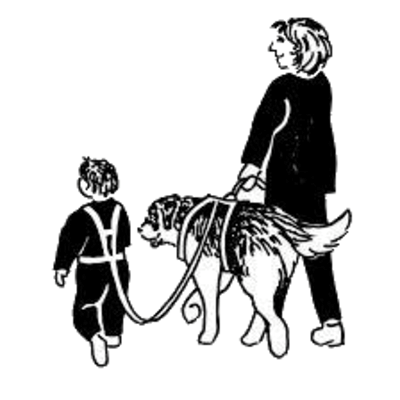
There are 10 different service dogs, and that number is still growing as we learn more and more every day of what these dogs can do for those individuals with visual and/or invisible disabilities.
We will review what each of these service dogs are and the important tasks they can do to help save a person’s life with a disability, whether visual and/or invisible.
Let us talk about Autism Service Dogs:
Who would have ever thought that a service dog for an individual on the Autism spectrum can perform tasks that can potentially save a person’s life with Autism? Service Dogs for Children and adults with Autism act as constant companions to children with autism to help them improve social interactions and relationships, expand verbal and nonverbal communication, teach life skills, increase interest in activities and decrease stress within the family.
There are 3 different levels on the Autism spectrum:
- The first level of autism is considered a mild form of ASD. Someone who would fall into this level of autism is capable of interacting with other people. However, they might still struggle and need coaching and assistance.
- Level two autism is a more acute category. People with this diagnosis struggle with everything mentioned in level one, just more intensely. Therefore, they need much more support.
- Level three autism is the most severe form of autism and will require the most amount of support and professional services. Generally, people with this level of autism are not able to handle daily situations by themselves.
Let us look at what that looks like in tasks they can perform for their handler and individual with autism. Here are a few of the common tasks that a service dog is trained for specifically but not limited to for autism:
1. Tracking-
Dogs have amazing noses and can be trained to learn the specific scent of individuals. Autism Service Dogs are trained in search and rescue skills to follow the child’s scent and to bring the parent or handler to the child. This skill can be done if the child with autism elopes from home, at the store, on vacation, etc.
2. Tethering-
While out in public, wandering can be prevented by utilizing a tether system in which the dog wears a harness that a tether/leash is attached to for the child to wear or hold. Note: the primary leash is always in the parent’s hand, and the parent must always have complete control over the service dog. Sometimes the child just holding the second leash is enough to give the child security and a boundary, so you see reduced attempts to wander. However, for some children or at certain times if something catches their eye or they become upset they may still dart off. In these cases, the guardian or handler would attach the leash to something the child is wearing, such as a belt or backpack, so the child can walk freely next to the dog, but if attempting to wander, the dog can act as an anchor.
3. Behavior Intervention-
There are several tasks that fall under this category such as:
• Interrupting Repetitive Behaviors- An Autism Assistance dog can be trained specifically to respond to a child’s repetitive behaviors, either by the parent or guardian’s command or by using the behavior the child engages in to trigger a response from the dog.
• Calming and preventing Meltdowns- An Autism Service Dog can be trained to help provide assistance with meltdowns by providing calming and comforting interactions on the handler’s command. For example, if the parent sees the child feeling overwhelmed, they can have the service dog perform deep pressure by laying across the child’s lap.
These are just some of the common tasks that an Autism service dog can provide to a child or an adult in any given setting to help give support to the individual and the handler of the service dog.
In closing: Folks, these dogs are amazing creatures and can-do amazing things for those that have disabilities. You may see an individual out in a public setting that “looks” different than what society would call the “norm” but in all reality, if you just take a moment to educate yourselves, listen, and watch others with disabilities you will find that they are NOT so different from you and I, but more so we are all so much alike in many ways. Let those with disabilities teach YOU something and not allow society to paint that picture for them that live it daily.


Leave a Reply